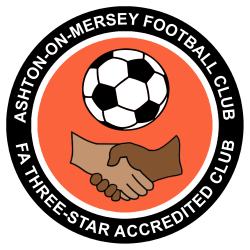Sports teams
Background
Ashton on Mersey Sports Club was formed in September 2023 following a merger between Ashton on Mersey Rugby Union Football Club and Ashton on Mersey Football Club.
The new organisation has nearly 700 members with the stated ambition of creating a thriving sports and social community at Banky Lane.
Click on the images below to take you to the dedicated sports team sites.
History
Ashton on mersey Rufc 1930 - 2012
Ashton on Mersey Rugby Club was formed in 1930 by disgruntled members of other local sides, namely Sale, Bowdon, Kersal and Metrovicks, who weren’t getting games elsewhere.

Ashton on Mersey RUFC Opening Season 1930/31
S McGregor, A Hampson, J Stafford, G Bissenden, J Newbury, J Wild, H Clarke, F Slinger
T Bowen, W A Wise, T Clarke, E Parker, T Edwards, J Gayter, G Pritchard
L Parrish
Meetings were held in ‘Bostocks’ sweet shop situated in Ashton Village opposite St. Martins School. By the start of 1930/31 the first fixture list had been prepared and the use of a field acquired on Whiteleggs farm on Harboro Road. Teams changed in the barn at Litherlands farm on Carrington Lane and bathed in tin baths using water heated by an outside boiler.
The premises were shared with the Ashton Silver Prize Band who used to parade and practise on the rugby ground as a prelude to matches. After three years at Kenilworth Road the land was required for building and from 1936 the club used grounds off Glebelands Road, near St Martins Church, now known as Romford Road estate. One constant embarrassment was the public footpath running across the second team pitch, when unsuspecting members of the public would stroll across the pitch. The club was now running four teams playing the likes of Winnington Park and Macclesfield. One of the more prominent members of the playing staff, F. Derrick, went on to play for England in the first Calcutta Cup match then played in India.
It was decided in 1939, due to the imminent outbreak of war and absence of members who were with HM forces, to suspend operations. It was six and half years later in 1946 before Ashton reformed. With no clubhouse or ground and with very little money, times were very difficult. Ground sufficient for one pitch was eventually rented from Sale Corporation which is now the site of the existing grounds, then known as Barracks Lane. An ex RAF hut from Stafford was acquired. This wooden and corrugated iron structure served as bathhouse and changing rooms for many years. No mains services existed. Water was hand pumped from a nearby well and heated in a coke fired boiler. When the old baths were replaced by brick baths and storm lamps replaced by electricity from an unreliable generator, it was perceived to be an achievement of great importance. During the erection of the corrugated building one club member on the roof was caught short and relieved himself, subsequently filling another member’s shopping bag draped across the handlebars of his Mum’s bike!
The club badge was first designed and adopted in 1954. The club colours, maroon and white, were overlaid by the unicorn, the family crest of the Trafford family, and three wheat sheaves, representing Cheshire.
A second pitch was leased from Sale Corporation. A wooden ex-army building was purchased and rebuilt giving Ashton its first clubhouse in its history. By then ground for a third pitch was made available by dynamiting a very large tree stump out of the ground. The work was carried out by a friend of a club member. The explosion did not impress the local fire brigades who thought an accident had occurred at the nearby chemical works. Meetings were held at the Brooklands Hotel and the Little ‘B’ – a tradition that lasted for many years.
Mains water, electricity and a licence were first brought to the club in 1956. 1961 brought back four sides again and a very successful colts side including Roy Maddock who went on to play for Sale 1st XV and was capped several times for Cheshire. The success of the colts team was largely due to the drive and determination of Peter Whiting. A new personality arrived at the club in the form of Andy Gormally in 1959 who was instrumental in taking the lead in social ventures including marquee balls attracting in excess of 2000 people.
In the early 1960s the club received some very unwelcome publicity when one of its members, being the son of a Knight of the realm was involved in divorce proceedings. One of those involved alleged that infidelity and wife swapping was rife at the club, resulting in half a page in the Daily Express’s gossip column, referring to Ashton as the ‘Old Canoodlians’.
A new clubhouse was eventually built in October 1967 at a time when Ashton were fielding seven teams every week. This was built on the current site of the existing clubhouse, which was doubled in size by building over and around on all four sides of the old clubhouse in 2002/2003 – giving us what we have today.
Ashton were the first club to start junior rugby in 1972. When leagues were first established in 1988 Ashton won their respective division four years on the trot. Various restructuring of the leagues left Ashton where they were even after being champions on those four consecutive occasions. We eventually got promoted to North West One in 1994, the highest position in the club’s history.
A major landfill exercise started in July 2000 and was completed in August 2001 culminating in the raised pitches becoming some of the best in the area. The early noughties saw the senior teams struggle with the 1st XV relegated and at times the club scraping to put a 2nd XV out. Conversely the junior/colts section thrived at this time. The latter half of the decade saw a rebuilding of the senior squads with three teams playing every week – resulting in a stable 3rd XV, two promotions for the 2nd XV and the 1st XV winning the Cheshire Plate in 2009 and promotion in season 2009/10 to South Lancs/Cheshire 1.
Ashton on Mersey Football Club
Ashton on Mersey JFC: A Chronicle of Community and Triumph
In the quaint backdrop of Wellfield Junior School’s sprawling fields, a humble yet spirited initiative took root in 1993. It was the year when Tony Lowe, with the green expanse of the school as his canvas, began painting a legacy with his football coaching centre. His backyard, a bridge to this canvas, became the storeroom for dreams and gear alike.
Tony’s vision was clear – to nurture talent right at home rather than see it whisked away to the ranks of other teams. It wasn’t long before his solo venture called for camaraderie, and in came Ed Salmon, a like-minded enthusiast from Prestwich and ex Bolton Wanderers player. Their partnership was more than serendipitous; it was a cornerstone for what was about to unfold.

Ed salmon, middle row, far-right
As the centre blossomed from 1993 to 1995, its ethos – football for all abilities – became its heartthrob. Its pulse grew stronger, and its reach spread wider, swiftly gaining recognition for its quality and uniquely enthusiastic approach. But with recognition came challenge. The centre’s thriving talent began to attract local clubs, eager to bolster their rosters for glory.
Determined to break the cycle of losing their stars, a strategic evolution took place. Wellfield Juniors was born, standing as a bastion against the plunder of their carefully nurtured players. Over the years, this change did more than just retain talent; it allowed the club to gain a formidable momentum, levelling the playing field with established clubs.
In an emblematic shift that mirrored their growth and community integration, Wellfield Juniors transitioned to Ashton on Mersey JFC in 1997. The new name was not merely a change of letters; it was an embodiment of the club’s philosophy and its synergy with the community spirit.
The reasons for the club’s growth were manifold. The Cheshire County Football Association took notice and forged a vital partnership, launching ‘School Club Link Programmes’ that spread Ashton on Mersey JFC’s influence across local junior and high schools. The club extended its embrace, offering football sessions to adults with learning and physical disabilities, and running a special program for children with Special Educational Needs at Manor High School. Their exemplary work did not go unnoticed, earning them the ‘Charter Standard Community Club of the Year’ award twice in three years.
But growth is not without its hurdles. An opportunity for the club to achieve its ambition of obtaining a home of its own looked like it was to be realised in 2007 after significant Football Foundation money was invested into a local site, building a clubhouse and changing rooms in the name of Ashton on Mersey JFC. Sir Alex Ferguson was there to open it!
Sadly, this was to be the breaking of a false dawn and following a dispute with the site owner, Ashton on Mersey JFC found themselves without a home and the club very nearly folded during this incredibly difficult time.
However, the club endured and turned adversity into a springboard for future success. The club introduced its U5 Tigers section and introduced a girls’ section for the first time, broadening inclusivity and fortifying their developmental ethos, although the girls section was relatively short-lived.
From 2014 onwards, Ashton on Mersey JFC not only recovered but thrived, expanding into multiple venues to support its growth. The traumatic events only served to galvanize the club, leading to a surge in membership, development of youth sections, and a cascade of football success with league and cup wins.
In September 2019, the club launched its girls section for a second time but this time, for good. As of the 2023/24 season, female members make up 1/3 of the total membership, with multiple teams at most age groups. The club itself has grown to over 50 teams and 600 members, covering the full range from U7 to adult teams in both the male and female game.
The history of Ashton on Mersey JFC is a tapestry woven with tenacity, community spirit, and a love for the game. From its inception to the present day, the club has not just survived; it has flourished, embodying the very essence of football – teamwork, passion, and an indomitable will to succeed.


